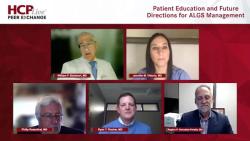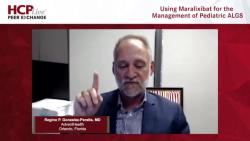Updates in the Management of Alagille Syndrome - Episode 12
Unmet Needs and Novel Agents for the Management of ALGS
Jennifer M. Vittorio, MD, and Philip Rosenthal, MD, comment on remaining challenges for the management of patients with Alagille syndrome and discuss novel therapeutic agents under investigation for disease management.
William F. Balistreri, MD: This will allow us to transition into looking ahead at how we’re going to use these tools. They still present some challenges to all of us. Jennifer, we’ve all used this drug in clinical practice. What are the remaining challenges? How does this fit into that nice treatment outline that you discussed with first tier, second tier, lots of tiers?
Jennifer M. Vittorio, MD: It’s funny. Reggie and I were engaged in a conversation talking about this earlier in the week. That seems to be the million-dollar question.
William F. Balistreri, MD: Literally.
Jennifer M. Vittorio, MD: That’s true. One thing that I’m interested in, that the studies didn’t look at, is pill burden. If patients are on additional medications, such as antipruritics, it’s not clear how many of our patients will be able to decrease the number of antipruritic agents that they’re taking. In other words, I’d love to be able to sit down and market this as monotherapy: that this is all we need, and this is the answer we’ve been waiting for. Some of that remains to be seen. That’s the hope within our community.
The second thing is: Where does everyone’s comfortable level lie? Are we comfortable using this up front? Are we going to shy away from using ursodiol at this point? Will it be combination therapy and then, if things go well, we’ll feel a little comfortable peeling things off? I’ve been asking myself those questions. Since this has been commercially available for only the last couple of months, I’m interested to see what the coming year shows. As you point out, that’s one of the big questions.
The other remaining challenge is recognition, making sure we get these patients to the appropriate specialist, such as ourselves, who will have more familiarity with this medication and can help guide patients in a way that they need to be guided. Disease awareness, marketing, and education to a lot of the players we talk about are important.
I’d be a little remiss if I didn’t talk about what happens as they get older and become young adults, and we’re looking to transfer them to our adult partners who may not be as familiar with taking care of patients with Alagille syndrome or as aware of lot of the intricacies or different organ involvement outside the liver. Perhaps they have some familiarity with some of these new therapies for other indications, so maybe we can take advantage of some of their experience there.
William F. Balistreri, MD: Exactly. Very well said. Obviously, we’re going to need more real-world data and clinical development profiles as these drugs continue to be utilized and marketed. Phil, is there anything else on the horizon in terms of follow-up of the ICONIC study, such as other drugs?
Philip Rosenthal, MD: Maralixibat is approved for use in patients over 1 year of age.
William F. Balistreri, MD: For Alagille, right.
Philip Rosenthal, MD: Right, for Alagille. Many of these patients have itching and cholestasis long before they’re 1 year old. There’s an ongoing trial for younger-age patients to be enrolled in a maralixibat trial. In the ICONIC trial, I believe there were only about 30 patients.
William F. Balistreri, MD: Thirty-one, right.
Philip Rosenthal, MD: We aren’t talking about large numbers. Perhaps when they get up to 60 patients on the drug, we might see benefits or disadvantages that we haven’t observed based on only 30 patients. There’s a lot of information that we’d still like to garner. For example, genetically, not everyone who has a JAG1 or NOTCH defect has the identical defect. Some data suggest that in PFIC [progressive familial intrahepatic cholestasis], PFIC2, and BSEP deficiency, there are differences in the genetic makeup as far as response to IBAT inhibitors. Perhaps the same occurs in Alagille syndrome, because not every patient has an excellent response to the IBAT inhibitor.
William F. Balistreri, MD: Well said, Philip. There’s also another IBAT inhibitor in development, odevixibat, which is approved for PFIC. We don’t have head-to-head comparisons—we may never—and we don’t know the relative binding affinity to the ileal receptor and so on. As Jennifer alluded to, we’ll gather a lot more data as we learn about this, and hopefully we can continue to share our experiences.
Transcript Edited for Clarity



